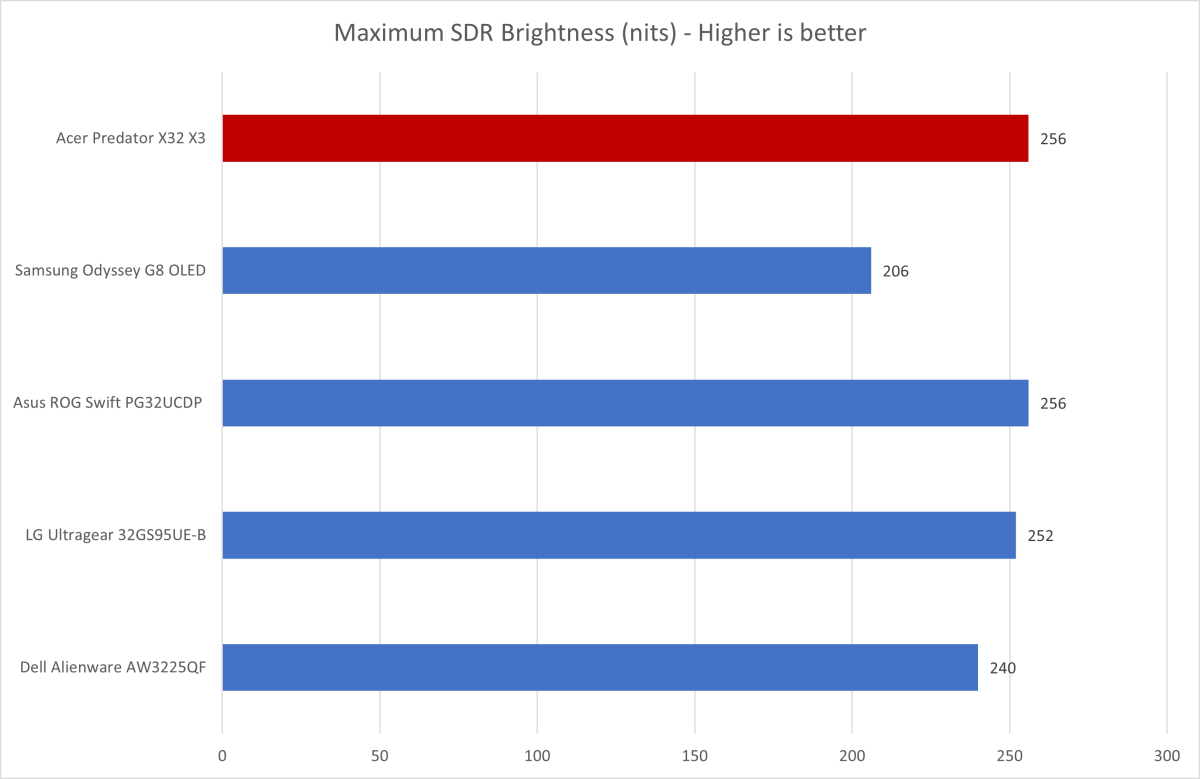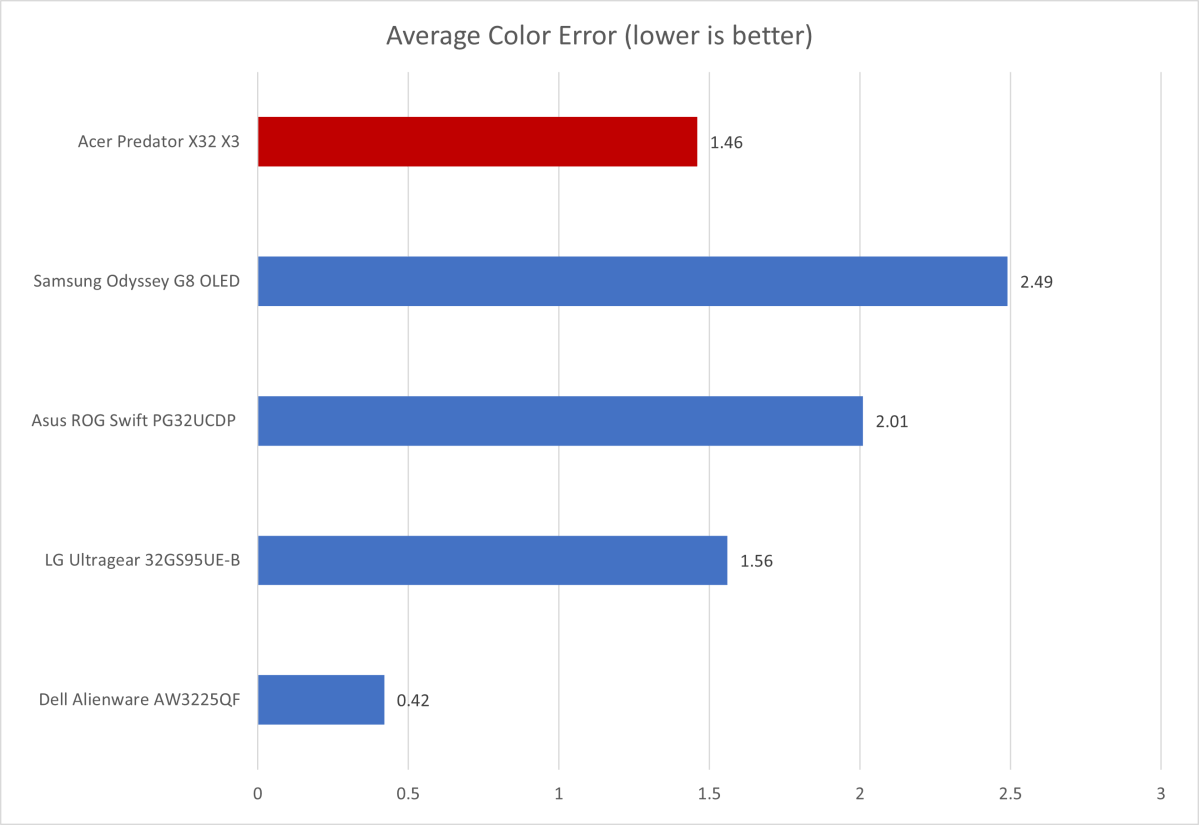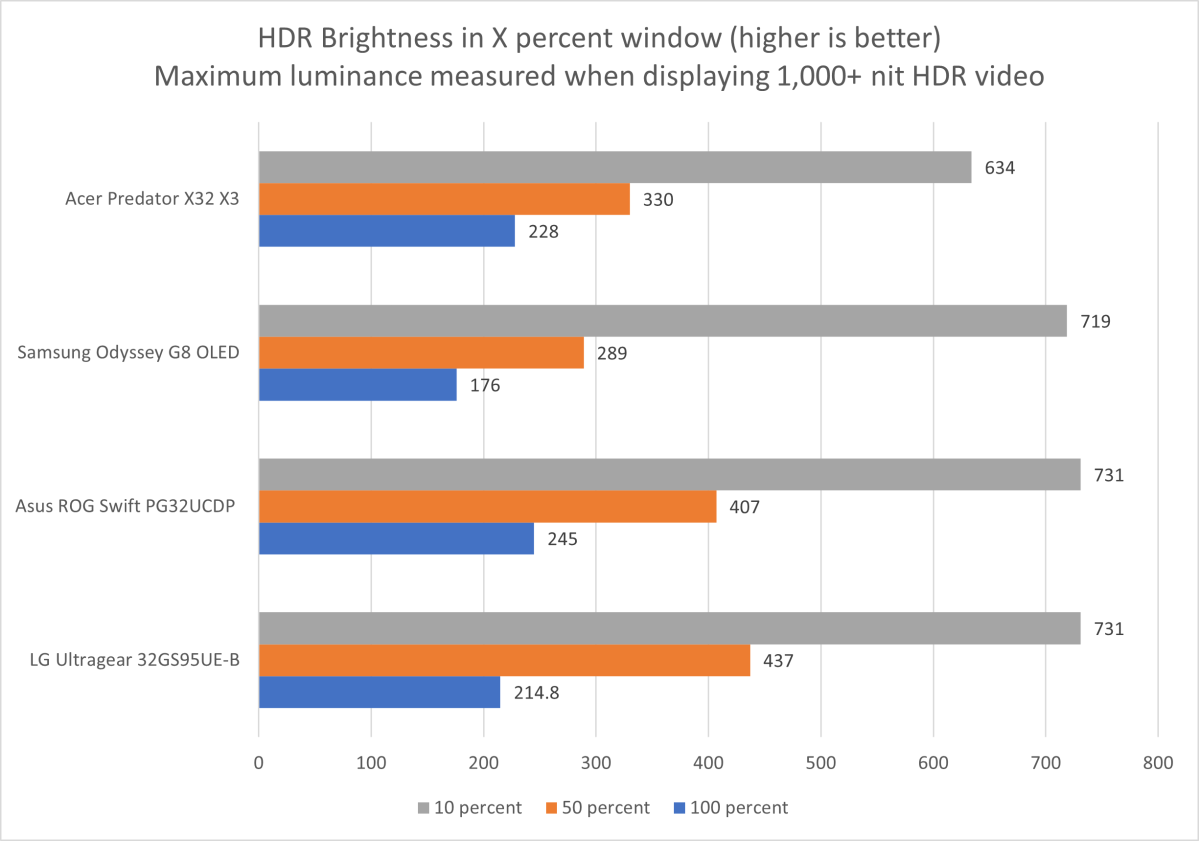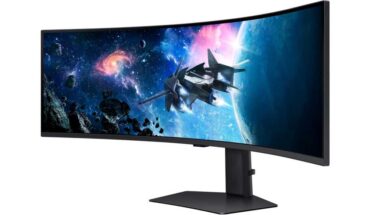Expert’s Rating
Pros
- Includes USB-C with 90 watts of Power Delivery
- Excellent contrast and color performance
- Top-tier motion clarity at 1080p up to 480Hz
- Affordable pricing relative to 4K OLED alternatives
Cons
- Dull design
- Stand is too large
- Image quality, though excellent, doesn’t stand out from competitors
Our Verdict
The Acer Predator X32 X3 is a more affordable 4K OLED monitor that packs a nice bonus: USB-C with 90 watts of Power Delivery.
Price When Reviewed
This value will show the geolocated pricing text for product undefined
Best Pricing Today
Price When Reviewed
$899.99
Best Prices Today: Acer Predator X32 X3
The current crop of 32-inch 4K OLED monitors are a personal favorite. They offer gorgeous image quality in both SDR and HDR alongside top-tier motion performance. However, most 32-inch 4K OLED monitors have two downsides: high pricing and a lack of USB connectivity. The Acer Predator X32 X3 tackles both issues.
Acer Predator X32 X3 (X3BMIIPHUZX) specs and features
The Acer Predator X32 X3 has outstanding specifications. It’s also rather mundane. Both are true because, like its direct competitors, the Acer Predator X32 X3 relies on a new generation of LG WOLED panel that can support 4K resolution at up to 240Hz or 1080p resolution at up to 480Hz. Several other monitors offer this panel.
- Display size: 32-inch 16:9 widescreen
- Native resolution: 3840×2160
- Panel type: LG WOLED
- Refresh rate: 4K up to 240Hz / 1080p up to 480Hz
- Adaptive sync: AMD FreeSync Premium Pro
- HDR: Yes, VESA DisplayHDR True Black 400 Certified
- Ports: 2x HDMI 2.1, 1x DisplayPort 1.4, 1x USB-C with DisplayPort Alternate Mode with 90 watts of Power Delivery, 3x USB-A downstream, 1x USB-C data downstream, 3.5mm audio out
- VESA mount: Yes, 100x100mm
- Speakers: 2x 5-watt speakers
- Price: $1199.99 MSRP / $879.99 typical retail
However, the Acer Predator X32 X3’s connectivity is a bit different from most. It has a USB-C port with 90 watts of Power Delivery, which is great to see and still not included on all premium gaming monitors.
The Acer Predator X32 X3 debuted with an MSRP of $1199.99, but was swiftly discounted to $879.99 (and, on Amazon, currently displays that as MSRP). That’s a big drop, and it’s significant to the Acer Predator X32’s standing against its peers. At MSRP, it’s a good choice but doesn’t stand out. At $879.99, it’s a great deal.
Further reading: See our roundup of the best 4K monitors to learn about competing products.
Acer Predator X32 X3 design
The Acer Predator X32 X3 has its strengths, but design isn’t one of them. From the front, the monitor appears rather generic, featuring slim bezels on the top and sides, a small bottom chin, and no visible Acer logo. The rear of the monitor is similarly unremarkable, with a simple matte black finish interrupted by a few textured panels. While it doesn’t look bad, it fails to stand out.
This subdued design does have its advantages, as it allows the monitor to blend seamlessly into a home office or professional environment. However, it lacks RGB LED accent lighting.

Matthew Smith / Foundry
While the Acer Predator X32 X3’s design is rather reserved, it strangely abandons that strategy with the wide, tripod-like stand. It’s nearly as wide as the panel itself and, because it’s not flat, the space it occupies can’t be used to place items on your desk. That’s a bit annoying if you want to use the monitor on a compact desk.
The stand allows the usual ergonomic adjustments, however, including height, tilt, and swivel. A 100x100mm VESA mount is included for use with third-party monitor stands and arms.
Acer Predator X32 X3 connectivity
The Acer Predator X32 X3’s design is a miss, but its connectivity is more promising. The monitor supports two HDMI 2.1 ports, one DisplayPort 1.4, and one USB-C with DisplayPort Alternate Mode. That’s a total of four video inputs, all of which can support the monitor’s maximum resolutions and refresh rates.
The USB-C port also supports up to 90 watts of Power Delivery. That’s notable for a couple reasons. First, not all 4K OLED monitors bother to support USB-C upstream: the LG Ultragear 32GS95UE-B and Alienware AW3225QF are two examples. Second, the Acer Predator X32 X3’s particular arrangement of ports lets users connect two game consoles (over HDMI), a desktop PC (over DisplayPort), and a laptop (over USB-C) simultaneously.
The USB-C port connects to three additional USB-A ports and one USB-C downstream port, which makes the monitor a useful USB hub for adding wired peripherals. The USB-C port, and one of the USB-A ports, are found on the lip of the lower bezel for easy access. The USB ports conform to the USB 3.2 Gen 1 standard.
The monitor lacks eARC support, however. Though uncommon among monitors as a whole, this can be found on 4K OLED monitors like the Alienware AW3225QF and might prove useful if you want to use a monitor with a soundbar.
Even so, I think the Acer Predator X32 X3’s ports are preferable to most of its competitors. Its arrangement of HDMI, DisplayPort, and USB-C provides options for every computer and game console, from a high-end gaming desktop to a MacBook Air to a PlayStation 5.
The X32 X3’s arrangement of HDMI, DisplayPort, and USB-C provides options for every computer and game console, from a high-end gaming desktop to a MacBook Air to a PlayStation 5.
Acer Predator X32 X3 menu and features
The Acer Predator X32 X3’s menus are controlled with a joystick centered behind the monitor’s lower bezel. It’s responsive (as true of most such joystick controls), and Acer’s on-screen menus are logically arranged. The menu text is a bit small, though, so it can be hard to read. Acer also provides a software utility called Acer Display Widget, which can be used to control most monitor features from within Windows.
Image quality customization is extensive. The monitor provides several gamma presets which target specific gamma values. There are also several color temperature modes, though these don’t target specific values and instead use imprecise labels (like “Warm”). The monitor has six-axis color calibration, as well. The monitor’s color space presets include sRGB, Rec.709, DCI-P3, and SMPTE-C.
Importantly, the Acer Predator X32 X3 has a Constant Brightness mode. This minimizes the brightness swings that OLED panels can suffer when rapidly transitioning between bright and dark content. I recommend that owners use this feature when using Windows and desktop apps.
Streamers and content creators will appreciate the inclusion of a tripod mount on the top of the Acer Predator X32 X3’s stand. Strangely, Acer doesn’t seem to talk about this in the monitor’s marketing, but it’s a rare extra. Asus is the only competing brand that routinely provides it. The mount can be used to attach a camera, microphone, LED light, and anything else that you can screw into the mount.
A pair of five-watt speakers round out the features. They’re not amazing, but they’re okay to use for podcasts or listening to chill beats at low volumes. LG’s Ultragear 32GS95UE-B, which has a unique “pixel sound” system, easily defeats the Acer on audio—but most competitors, like the Alienware AW3225QF, lack speakers.
Acer Predator X32 X3 image quality
The Acer Predator X32 X3 has an LG WOLED panel that supports up to 4K resolution. It’s also a 10-bit panel, which means it should deliver great color performance in both SDR and HDR.

Matthew Smith / Foundry
We start off with sustained SDR brightness, which is a weak spot for OLED monitors. The Acer Predator X32 X3 is not different, as its maximum of 256 nits falls right in line with other 4K OLED monitors.
This level of brightness is fine for general use in a room with light control. If you can turn off the lights, or close the blinds, you’re likely to end up using the monitor at roughly half its maximum brightness, or less. But if your room has bright, sunlit windows, or you work in an office with lights you can’t control, then the Acer Predator X32 X3 could look a bit dim at times.
The monitor has an anti-glare coating. This is a topic of some debate among OLED enthusiasts. Some prefer a glossy finish for its perceived contrast and clarity, while others prefer matte for practical use in rooms with mixed lighting. I’m in the second camp, as an anti-glare coat makes the most of OLED’s meager brightness.
While the monitor isn’t especially bright, it delivers an effectively infinite contrast ratio that provides an amazingly immersive, alluring image. This is made possible because the OLED panel can reduce the brightness of each pixel to zero nits, which enhances realism in dark scenes and amplifies contrast between bright and dark pixels. It’s a huge benefit, but one shared by all modern OLED monitors, so the Acer Predator X32 X3 has no advantage over its competitors here.

Matthew Smith / Foundry
The Acer Predator X32 X3’s color gamut highlights the difference between LG WOLED and Samsung QD-OLED panels. The QD in QD-OLED stands for Quantum Dots, a technology that allows monitors like the Samsung Odyssey G8 OLED to achieve a wider color gamut than LG WOLED alternatives. That places the Acer Predator X32 X3, which has the LG WOLED panel, behind some of its competitors.
With that said, though, the Acer Predator X32 X3 can still display up to 96 percent of the DCI-P3 color gamut and 87 percent of AdobeRGB. These are solid results that deliver a vibrant, saturated image.

Matthew Smith / Foundry
The Acer Predator X32 X3’s color accuracy is solid across the board. Though it’s not the most accurate LG WOLED monitor I’ve tested, it’s competitive with the alternatives.
The monitor also did well in gamma and color temperature testing. The gamma curve came in at 2.3, which is only a hair off the target of 2.2. That means the image is a tad darker than it should be, but it’s hard to notice. Color temperature came in right on target at 6500K, which is our preference. That means the image doesn’t look too warm and rosy, nor too cool and sterile.
Sharpness is good. 4K resolution on a 32-inch panel works out to about 138 pixels per inch (PPI), which is much higher than a 1440p 32-inch monitor’s pixel density of 92 PPI. Small objects and fonts generally look sharp, though some pixelation and aliasing are visible if I lean in to view the monitor more closely. OLED monitors tend to suffer sub-pixel rendering issues that can reduce sharpness compared to an IPS panel monitor, but this problem is much less noticeable on a 4K 32-inch monitor like the Acer Predator X32 X3 than on a 27-inch 1440p monitor like the ViewSonic XG272-2K-OLED.
Overall, the Acer Predator X32 X3’s SDR image quality is excellent, though it doesn’t stand out from other 4K OLED monitors. It has an effectively infinite contrast ratio, a decent color gamut, good color accuracy, and reasonable SDR brightness. The monitor’s performance in all these areas is similar to other monitors that have the same LG WOLED panel, and a tad behind competitors that use a Samsung QD-OLED panel.
Acer Predator X32 X3 HDR image quality
The Acer Predator X32 X3 supports HDR and is VESA DisplayHDR 400 True Black certified. Its overall HDR performance is generally in line with competitive OLED monitors—which is good news, as modern 32-inch 4K monitors are a solid choice for HDR.

Matthew Smith / Foundry
HDR brightness isn’t exceptional, but it’s solid. The Acer Predator X32 X3 generally wasn’t as bright as the Asus ROG Swift PG32UCDP and LG Ultragear 32GS95UE-B, but it’s not too far behind—I think it’s debatable whether this is a noticeable difference in real-world viewing.
It’s also worth mention that the alternatives are stiff competition. If the Acer Predator X32 X3 is compared to a less expensive 4K IPS monitor, like the Acer Nitro XZ320QK, the Predator is clearly superior.
Acer Predator X32 X3 motion performance
The Acer Predator X32 X3 is a “dual-mode” monitor, which means it is designed to accommodate two different native resolutions with varying refresh rates. To be specific, it supports 4K resolution at up to 240Hz or 1080p resolution at up to 480Hz.
While this might seem odd, it’s not just a gimmick. Want to get sweaty in Apex: Legends? Switch to 1080p/480Hz. Want to enjoy Cyberpunk 2077 at maximum sharpness? Flip back to 4K/240Hz. Acer is not the first monitor to offer this feature, however, as alternatives like the LG Ultragear 32GS95UE-B and Asus ROG Swift PG32UCDP also provide it.
The 1080p/480Hz mode arguably represents the upper end of motion clarity available from any modern display. Fast-moving objects look razor sharp and small text is generally readable even when it zooms across the screen. I personally find the improved clarity easy to notice. The 4K/240Hz mode isn’t as crisp in motion, but is also quite clear, and provides an obvious upgrade over older 4K monitors with a 60Hz to 144Hz refresh rate.
Adaptive sync is supported, though Acer only lists official support for AMD’s FreeSync Premium Pro. The monitor’s adaptive sync should generally function with Nvidia G-Sync and VESA Adaptive Sync compatible video inputs, as these standards are related, but I wasn’t able to test this first-hand.
Should you buy the Acer Predator X32 X3?
The Acer Predator X32 X3 is a great 4K OLED monitor that separates itself from the competition on two key points: connectivity and price.
Acer provides a USB-C port with USB Power Delivery alongside several downstream USB-A ports, which gives the monitor an advantage over its peers when it comes to connectivity (as most lack USB-C). Acer also hits a slightly lower retail MSRP which, at time of this writing, undercuts competitors by $30 to $130 dollars. The Predator X32 X3’s stand is a bit wider than it should be, and the monitor lacks RGB LED lighting, but I expect many shoppers will be willing to overlook those small design shortcomings.
That makes the Acer Predator X32 X3 easy to recommend so long as it maintains a slight price advantage over its peers.





